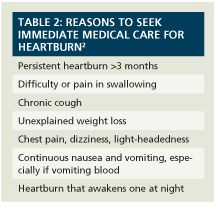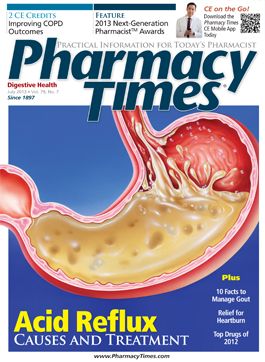Publication
Article
Pharmacy Times
Putting Out the Fire: Relief for Heartburn and Dyspepsia
Author(s):
Here are the essentials for advising patients on nonprescription products for managing, preventing, and treating heartburn and dyspepsia.
Here are the essentials for advising patients on nonprescription products for managing, preventing, and treating heartburn and dyspepsia.
Pharmacists are likely to encounter patients seeking advice on nonprescription products for management, prevention, and treatment of heartburn and dyspepsia.
They are also in a pivotal position to identify patients at increased risk of developing heartburn due to their use of certain pharmacologic agents or due to the fact that they have certain medical conditions or lifestyle habits. According to the American College of Gastroenterology, an estimated 60 million people in the United States experience heartburn at least once a month, and more than 15 million experience it daily.1
Heartburn is characterized by a burning sensation that usually arises from the substernal area and moves up toward the neck or throat.2 Before recommending any nonprescription product for heartburn and dyspepsia, pharmacists should determine whether self-treatment is appropriate. Episodes of heartburn that are frequent, persistent, or last 3 months or longer are the most common symptoms of gastroesophageal reflux disease (GERD). If left untreated, GERD can lead to long-term complications such as esophagitis, gastrointestinal bleeding, Barrett’s esophagus, and esophageal cancer.2,3 Patients with frequent episodes of heartburn or severe heartburn symptoms should always be encouraged to seek further medical evaluation as soon as possible, as recent studies from the American Cancer Society report that chronic heartburn may increase one’s risk of throat cancer.4
Common Heartburn Symptoms
Heartburn and dyspepsia may produce the following symptoms: a painful burning sensation in the chest just behind the breastbone typically 1 to 4 hours after eating; a sour or bitter taste in the mouth; regurgitation of food; chest pain; excessive burping; a hoarse, sore throat; coughing or choking, especially when lying down; and frequent sleep interruptions due to indigestion.1,2,5,6 In addition, factors that can contribute to or exacerbate episodes of heartburn and dyspepsia include dietary or lifestyle choices, use of certain medications, and certain medical conditions1,2,5-7 (Table 11,2,5-10).
Table 1: Factors that may trigger/exacerbate episodes of heartburn/dyspepsia1,2,5-10
Dietary Habits
Lifestyle Habits
Pharmacologic Agents
Medical Conditions
- Eating less than 2 hours before bedtime
- Consuming large meals
- Consuming foods such as citrus fruits, chocolate, peppermint, tomatoes, raw onions, garlic, black pepper, and fatty or spicy foods
- Consuming alcoholic beverages, particularly close to bedtime
- Consuming beverages such as coffee, tea, citrus juices, and caffeinated or carbonated beverages
- Being overweight/obese
- Lying down within 2 hours after eating
- Eating too rapidly
- Certain types of exercises (weight lifting, cycling, sit-ups)
- Restrictive or tight clothing
- Smoking
- Stress
- Anticholinergic agents
- Aspirin, NSAIDs
- Benzodiazepines
- Beta-blockers
- Bisphosphonates
- Calcium channel blockers
- Chemotherapy
- Dopamine
- Estrogen
- Iron salts
- Narcotic analgesics
- Nitrates
- Potassium
- Progesterone
- Tetracyclines
- Theophylline
- Tricyclic Antidepressants
- Zidovudine
- Diabetes
- Asthma
- GERD
- Hiatal Hernia
- Motility disorders (eg, gastroparesis)
- Pregnancy
- Peptic ulcer disease
- Scleroderma
- Zollinger-Ellison syndrome
Nonprescription Products
Self-treatment of heartburn or dyspepsia may include dietary and lifestyle modifications and use of nonprescription medications. Mild to moderate cases of heartburn and dyspepsia are generally easily managed with the available nonprescription products, which include antacids, histamine-2 (H2) receptor antagonists, proton pump inhibitors, and bismuth subsalicylate, marketed as Pepto Bismol (Procter & Gamble).2 In addition, Bayer Healthcare recently introduced a new product for heartburn relief: Alka-Seltzer Fruit Chews.
Antacids
Antacids, which work by neutralizing gastric acid, are indicated for treatment of mild, infrequent heartburn and indigestion. 2 Antacids should be taken at the onset of symptoms and typically produce relief within 5 minutes of administration. 2 Patients taking agents including tetracyclines, digoxin, iron supplements, fluoroquinolones, and ketaconazole should be advised not to use antacids within 2 hours of ingesting them.2 Patients with impaired renal function should not use antacids containing aluminum and magnesium and should consult with a physician before using any antacids.2 Patients should be advised to only take the recommended dose and not to take antacids more than 4 times per day or on a regular basis for longer than 2 weeks.2
Histamine2-Receptor Antagonists
Nonprescription H2-receptor antagonists (cimetidine, ranitidine, famotidine, and nizatidine) are indicated for the treatment of mild to moderate infrequent or episodic heartburn and for the prevention of heartburn associated with acid indigestion and dyspepsia.2 These agents decrease gastric acid secretion by inhibiting the effect of histamine on the H2 receptor of the parietal cell.2 They should be taken at the onset of symptoms or at least 1 hour before symptoms are experienced. Combination products that contain an H2-receptor antagonist and an antacid appear to provide faster relief of heartburn. 2 Symptoms are typically relieved within 30 to 45 minutes of administration.2 Self-treatment dosing with these agents should be limited to twice per day.2 The most common adverse effects of H2-receptor antagonists include headache, dizziness, diarrhea, drowsiness, and constipation.2 Examples of drugs that may interact with cimetidine include theophylline, antidepressants, antianxiety agents, phenytoin, and warfarin.2

Two proton pump inhibitors (PPIs), omeprazole and lansoprazole, are currently available as nonprescription heartburn products. They are indicated for individuals 18 years and older for the treatment of frequent heartburn, defined as heartburn that occurs 2 or more days per week.2,10,11 PPIs are not intended for immediate relief of occasional or acute heartburn episodes.2,11,12 PPIs should be taken once a day with a glass of water in the morning and are most effective when taken 30 to 60 minutes before a meal, preferably breakfast. Duration of self-treatment should be restricted to a 14-day course of therapy, which should be repeated no more frequently than once every 4 months.2,11,12 It is imperative that patients be advised to complete the full 14-day course of therapy. Symptom relief may occur starting 2 to 3 hours after taking a dose, but complete relief may take 1 to 4 days after starting therapy.2,11,12 The tablet or capsule should be swallowed whole, not chewed or crushed. If symptoms persist after completion of therapy or recur within 4 months, patients should be encouraged to seek medical evaluation.2,11,12 Common adverse effects associated with PPIs are comparable to those of H2-receptor antagonists. Examples of potential drug interactions associated with PPIs include pharmacologic agents such as warfarin, ketoconazole, diazepam, digoxin, atazanavir, and tacrolimus.2,11,12
Factors to consider when selecting a nonprescription agent for self-treatment for heartburn include condition severity, frequency and duration of symptoms, dosing intervals, dosage form, potential drug—drug interactions, contraindications, and cost.2 Pharmacists can also suggest nonpharmacologic measures to help treat heartburn, such as smoking cessation, weight loss, avoiding late-night eating, eating smaller meals, not exercising immediately after eating, avoiding foods and drinks that may aggravate or contribute to heartburn, and avoiding lying down within 30 minutes of eating.2,9-14 Pharmacists should determine whether self-treatment is appropriate and screen for possible drug—drug interactions or contraindications before recommending any of these products. In addition, individuals with pre-existing medical conditions, those younger than 12 years, and pregnant or lactating women should consult their primary health care provider before using any of these products. Patients with recurring and persistent episodes of heartburn and those exhibiting atypical or severe symptoms should always be referred to their primary health care provider for further medical evaluation. If symptoms worsen or show no sign of improvement after 14 days of self-treatment, patients should seek immediate medical care as well.2
An excellent patient resource regarding heartburn and GERD can be found on the American College of Gastroenterology website at http://s3.gi.org/patients/pdfs/UnderstandGERD.pdf.
Ms. Terrie is a clinical pharmacy writer based in Haymarket, Virginia.
References:
- American College of Gastroenterology. Understanding GERD. http://s3.gi.org/patients/pdfs/UnderstandGERD.pdf. Accessed June 5, 2013.
- Zweber A, Beradi R. Heartburn and dyspepsia. In: Krinsky D, Berardi R, Ferreri S, et al, eds. Handbook of Nonprescription Drugs. 17th ed. Washington, DC: American Pharmacists Association; 2012.
- GERD. Medline Plus. www.nlm.nih.gov/medlineplus/gerd.html. Accessed June 2, 2013.
- Chronic heartburn may raise odds for throat cancer. Medline Plus. www.nlm.nih.gov/medlineplus/news/fullstory_137128.html. Accessed June 1, 2013.
- Heartburn, GER and GERD. National Digestive Diseases Information Clearinghouse. http://digestive.niddk.nih.gov/ddiseases/pubs/gerd/#2. Accessed June 2, 2013.
- Zantac OTC: learn about heartburn. Boehringer Ingelheim. www.zantacotc.com/heartburn/index.jsp. Accessed June 2, 2013.
- Causes of heartburn. Mylanta Products. McNeil Consumer. www.mylanta.com/causes-heartburn. Accessed June 2, 2013.
- Acid reflux. The American College of Gastroenterology. http://patients.gi.org/topics/acid-reflux/. Accessed June 3, 2013.
- Heartburn triggers. Zegerid OTC. MSD Consumer Care. www.zegeridotc.com/zegeridotc/heartburn/heartburn-triggers.jspa. Accessed June 3, 2013.
- What is heartburn/acid indigestion? Tagamet HB. Prestige Brand. www.tagamet.com/en/about-heartburn.aspx. Accessed June 3, 2013.
- Prevacid 24HR capsules product information. Novartis Consumer Health, Inc. www.prevacid24hr.com/24-hour-relief.jsp. Accessed June 3, 2013.
- Zegerid OTC Product Information. MSD Consumer Care. www.zegeridotc.com/download/zegeridotc_product_labeling.pdf. Accessed June 3, 2013.
- Heartburn prevention. Mylanta Products. McNeil Consumer. www.mylanta.com/heartburn-prevention. Accessed June 2, 2013.
- Protect against heartburn. Prilosec OTC Product. Procter & Gamble. www.prilosecotc.com/Frequent-Heartburn/Protect-Against-Heartburn. Accessed June 2, 2013.







